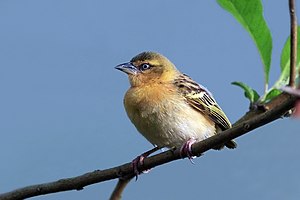Riedweber
| Riedweber | ||||||||||||
|---|---|---|---|---|---|---|---|---|---|---|---|---|

Reed weaver ( Ploceus castanops ), female |
||||||||||||
| Systematics | ||||||||||||
|
||||||||||||
| Scientific name | ||||||||||||
| Ploceus castanops | ||||||||||||
| Shelley , 1888 |
The reed weaver ( Ploceus castanops , syn. Loxia castanops ) belongs within the family of weaver birds (Ploceidae) to the genus of the bunting weaver ( Ploceus ).
The Latin additional species comes from ancient Greek κάστανον kastanon , German 'chestnut (brown)' and ancient Greek ὤψ ops , German 'face' .
The bird is found in East Africa in northern Burundi , in the east of the Democratic Republic of the Congo , in western Kenya , in Rwanda , in northwestern Tanzania and in Uganda .
The distribution area includes moist habitats along rivers and lakes, especially overgrown with papyrus or reeds, also in the vicinity of arable land of 900–2000 m altitude.
features
The species is 14 cm tall and weighs between 18 and 27 g. In the breeding plumage, the male has a dark chestnut-brown mask tapering towards the chest, looking almost black around the eyes and the base of the beak. The iris is whitish in contrast to Kilomberoweber ( Ploceus burnieri ), in which the iris is dark brown. The forehead is maroon, parting and neck golden yellow, the top olive green with dark stripes. The similar brown-throated weaver ( Ploceus xanthopterus ) is somewhat larger and lighter, differs in its yellow forehead and dark eyes. The female has a brownish upper surface and is similar to the black- headed weaver ( Ploceus melanocephalus ), but has whitish eyes. Fledglings look like females, but with dark eyes.
The species is monotypical .
voice
The male's song is described as a high-pitched chirping with various hissing and squeaking noises. The bird sing persistently to defend its territory.
Way of life
The diet consists mainly of seeds including millet , also insects . It hunts in small groups, often with other weaver birds on the ground and on floating plants.
The species can breed in any month with a focus on March to May and September in Uganda, February to May and July in the Democratic Republic of the Congo. The species is probably monogamous , likes to breed in colonies . The clutch consists of 2 to 3 pink or pale blue eggs, possibly red-brown spotted or monochrome. Both parent birds feed them.
Hazardous situation
The stock is not considered to be at risk ( least concern ).
literature
- GE Shelley: Ploceus castanops in: Proceedings of the Zoological Society of London. London, 1888, p. 35, Biodiversitylibrary
Web links
- Videos, photos and sound recordings of Ploceus castanops in the Internet Bird Collection
- Weaver Watch
Individual evidence
- ↑ Ried Weber , in Avibase - The World Bird Database
- ^ JA Jobling: A Dictionary of Scientific Bird Names. Oxford University Press. 1991. ISBN 0-19-854634-3 .
- ↑ a b c d Handbook of the Birds of the World
- ↑ a b c d T. Stevenson, J. Fanshawe: Birds of East Africa. Kenya, Tanzania, Uganda, Rwanda, and Burundi. Princeton University Press, 2002, ISBN 978-0-691-12665-4 .
- ↑ Old World sparrows, snowfinches, weavers
- ↑ Redlist
